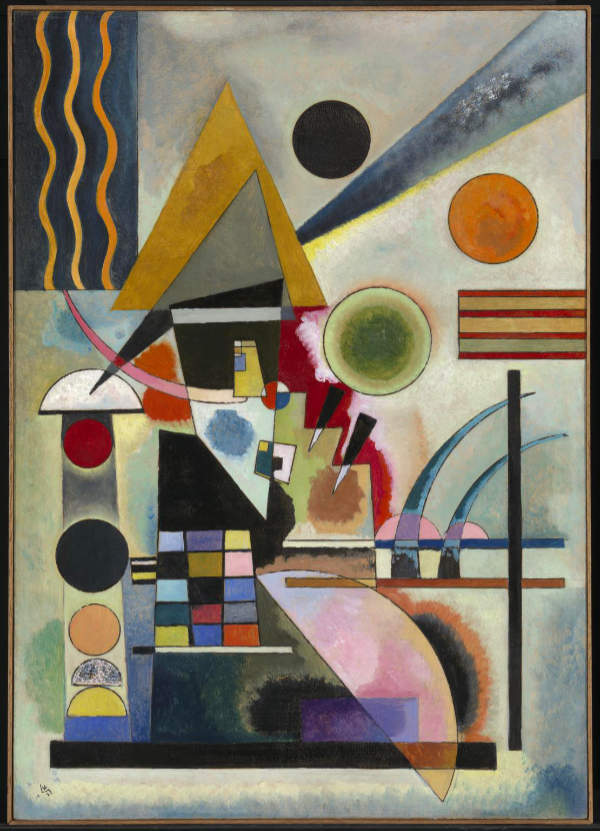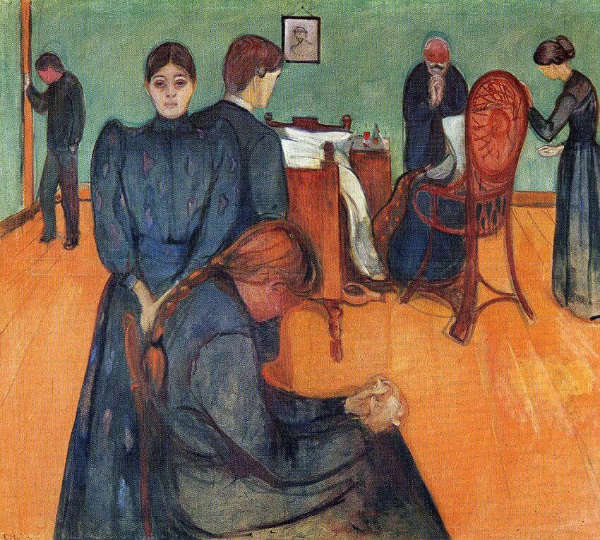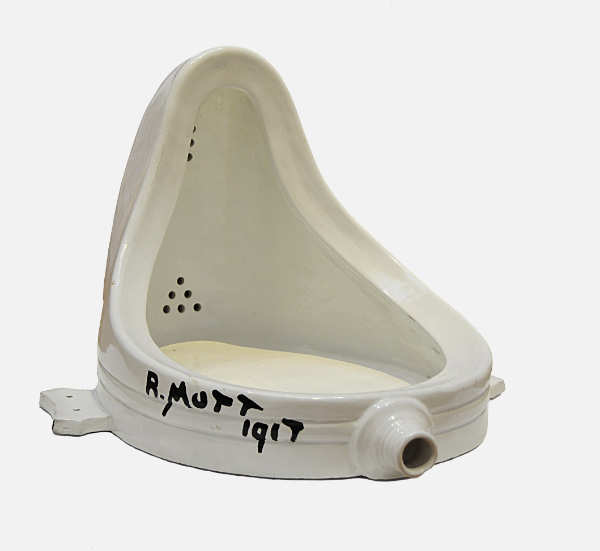The Big Question
Why should we look at Art?
Have you ever wandered around an art gallery and wondered what art is all about, or even why the art works were actually there at all? It seems the days of the heavily carved gold frames and dark, varnish encrusted paintings have long since been replaced by beds, dead animals, endless videos and even lumps of ‘rubbish’. Should we not blame the artist, after all they can hardly be classed as ordinary people can they? Normal individuals don’t chop up cows and call it art, cut off part of their ears, tape bananas to gallery walls, or spend years of their life on their back painting ceilings.
Yet these strange individuals have changed our world. Damien Hirst with his famous cow and sheep sculptures has made us re-consider our treatment of animals in a fundamental way. Van Gogh, despite giving part of his ear to a girl at a brothel and spending time in a mental institution, gave us paintings that explore the human condition in a way no other artist has managed. Michelangelo, who apparently had an aversion to washing, used to wear his leather breeches for months at a time without taking them off – he must have smelt awful – yet he gave us the sublime masterpiece that is the Sistine Chapel.
Why should we see art as important? Why should we bother acknowledging the outpourings of these strange individuals, these artists and their art? It is simple really. We look at art because it is endlessly fascinating. It makes us think and it challenges our ideas and beliefs. Whether we are looking at a Rembrandt portrait or Tracy Emin’s bed there is always something to discuss or argue about. Remember that art is not created simply to be enjoyed, to fill that gap on a wall in the lounge, or be accepted as being profound because it is popular. There is a bit more to it than that.
Art reflects life; it can be wonderful, frustrating, beautiful or ugly. It can have a deep philosophical meaning, or it can be fun and frivolous, strongly political, or morally uplifting. It also reflects the society in which it was produced, which is why art produced in Nazi Germany is so different from that produced in France during the 1870’s.
Judging or appreciating paintings is a subjective process, but it can also be seen as an exciting journey through the life and times of artists. A little background knowledge plus a basic understanding of the elements of art, and our adventure will be much more satisfying. So let us start our journey by gaining a little background knowledge and understanding.

“There’s no retirement for an artist, it’s your way of living so there’s no end to it.”
Henry Moore

“I saw the angel in the marble and carved until I set him free”
Michelangelo
The First Big Question
What is Art?
Art is what artists produce. All artists are human beings, but not all human beings are artists. So, what is it that makes a human being an artist? And what is it that they produce? These simple questions are the basis of endless debate so lets break it down into simple chunks.
There seem to be three common threads running through all definitions of art:
- We expect to see some form of manual or technical skill, something we are not ourselves capable of, or which we aspire to. We can see this in lots of walks of life, sport, the arts as well as painting, drawing and sculpture. However, it is important that we do not see this as the most important or only criteria.
- We also expect to encounter some form of intellectual challenge, something that confronts our ideas, thoughts, and beliefs, but has no definitive answer, something akin to a political or religious discussion.
- Finally, we should see some form of personal or public expression, feeling, emotion that communicates what the art is about. When we hold a conversation we express our ideas and thoughts, it is the same type of process.
The three points mentioned above describe a lot of things humans produce so what else do we need to understand to define what art is? Let’s start with the word Art itself. Art is related to the word artificial in the sense that art is not naturally occurring like a tree, man creates art. It does not follow that anything man produces is Art. Why is this?
There is something different, more profound about Art compared with what is simply manufactured by man. For example, let’s compare a sculpture of a human figure with a manufactured nail. The sculpture can tell to us something about the human form or condition, where as the nail is simply a functional object with little or no real significance. On the other hand a nail is a very useful object where as, in a practical sense, a sculpture is not. So, art seems to be a group of objects, ideas or activities, which it could be argued are useless in practical terms, yet are different or significant in a way that a nail or painting a window frame is not.
Art constantly changes and as each century passes by, artists change the direction of art, or in some cases redefine it altogether. In the early 20th century, the artist Marcel Duchamp invented the ready-made, a work of art created from found objects, and made us look at everyday objects in a quite different way. Artists such as Hilma af Klint and Wassily Kandinsky choose to reduce the world to series of lines, colours and shapes and invented abstraction with its consequent effect on design, architecture and fashion.
It is not just artists that change art; technology has also made its mark. Without the invention of the camera obscura (the simple pin hole camera) some artists would have struggled to create their topographical paintings. Luckily the paint tube was invented before the 1860’s; otherwise the ability of the Impressionist painters to work outside would have been almost impossible. Today we see computers influencing everything from animation to special effects and generating new forms of art at the same time, just as the invention of photography did in the 19th century. And who knows where AI will take us?
What does it mean to be an Artist?
These Attributes would be Useful
We have established how art is different from the other products and activities of human beings, but what is it that the artist actually does and what does it mean to be an artist? A list of qualities might be useful. The list could be endless, but the following does give us an idea of what it is that constitutes being an artist. He or she may not have all, but a number of the following attributes will be applicable:
Virtuosity
The artist has to have mastery of the techniques and skills with which he creates art. Like all great artists and indeed sportsmen, musicians and actors as well, true virtuosity makes the mastery of technical skills look deceptively easy. Other elements here might include:
- The intention to produce something – art is not produced by accident. No, chimpanzees, elephants or cows don’t produce it. The ability to produce more than an accidental one off is crucial.
- A desire to illustrate – the ability to produce in two dimensions what we see in three.
- The ability to exhibit a skill – for example, drawing to a level we would see as being above the ordinary.
- Art is self rewarding activity – the artist should enjoy what he is doing.
Innovation
Since the Renaissance in Western Society we have encouraged, praised and valued innovation. To be the first in any endeavour often ensures a place in history. This is why artists such as Picasso are seen as giants of art, because they innovate whereas others develop or extend the innovation of others. Innovation by definition challenges accepted rules, conventions and ideas. To be a true innovator requires great courage and determination. Ways in which this might be achieved could include some of the following:
- An ability to unite dissimilar things – e.g. Picasso’s Bull made from the saddle and handle bars of a bicycle
- A fascination with change and variety – artists constantly try to offer new insights on the world, or change and challenge accepted ways of doing, seeing or accessing things
- An ability to create illusions – M S Escher manipulated space in his graphic drawings to make us believe that water could indeed flow upwards as well as down.
- Challenging the familiar with elements of surprise – Rene Magritte was a master of surprise. His painting The Call of the Summit 1942 is a good example.
- Imposing order on disorder – the classical landscape gardener Capability Brown brought order on the chaos of nature
- The ability to manipulate our perception of reality – we have only to look at any painting by Salvador Dali to see how artists can influence the way we perceive the world
Artistic Vision
Artists who have a total belief in and complete commitment to, the works they are producing usually produce truly great works of art. The total belief in an idea and the use of painting, or other artistic means to produce it, is what also raises painting above what would otherwise be simple decoration or illustration. Artistic vision can also refer to the ability to see, exploit or give meaning to the chaos and absurdity thrown up by nature and humanity, or see relationships between things seen or felt that others often don’t. Other related attributes might be:
- A desire to make sense of life – artists may try to offer meaning or interpretation of life’s great or insignificant moments for example, Edvard Munch’s painting, Death in the Sickroom
- The creation of fantasy – artists such as Richard Dadd created a mystical world based on Shakespeare’s play, A Mid Summer Nights Dream in his painting, The Fairy Feller’s Master Stroke
- Indulging in sensuousness – an example might be Velasquez’s painting of the Rokeby Venus 1648
- The glorification of self or others – good examples are Jacques Louis David’s painting of The Crowning of Napoleon’ or elements of Michelangelo’s painted ceiling in the Sistine Chapel in Rome
- A wish to shock or surprise – Damien Hirst uses shock tactics to make us consider our attitudes towards the use of animals for food in such works as, This little Piggy went to Market and this little Piggy stayed at Home
Now we have some understanding of what artists do and what art is about. The next step in appreciating art is to understand what makes a work of art and how we can organise what we feel or understand the art work to be. Before we do this let us consider some of the common statements often heard when the public come into contact with art.

“There are painters who transform the sun into a yellow spot, but there are others who, thanks to their art and intelligence, transform a yellow spot into the sun.”
Pablo Picasso

“I shut my eyes in order to see.”
Paul Gauguin



